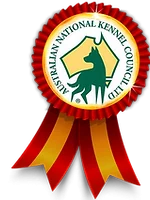French Bulldog Health Information
Return to main page
GENERAL
The French Bulldog, is on the whole, a fairly sound dog with a few structural problems that need to be noted and that breeders need to be
aware of. Being a brachycephalic breed that is fairly short and compact with a screw tail, the “Frenchie” is prone to the associated problems
these conformational characteristics will bring.
Body – While small in size, the Frenchie is incredibly solid for its height and weight, which to the uninitiated, can be very deceptive. The breed is
a miniature mollossoid (mastiff), in that a large head and solid body is called for. The height at the shoulder relative to the bone and muscle
weight ratio is phenomenal when comparing this breed to almost any other. Males ideally should weigh around 12.5kgs, bitches around 11kg.
Despite their small stature, the strength of the Frenchie holds it in very good stead. The strength of bone and generally good ligament strength
makes them quite a hardy breed, unlikely to break bones or injure themselves, even though they play fairly hard. Launching off beds and chairs
even while quite young rarely causes any damage – only heart attacks to the owners!
The French Bulldog is also incredibly agile on the whole, able to spring up onto sofas, chairs, lounges, beds etc in a single bound – usually
without having to back off and take a run at it. In play, they often jump up in mid air, turn 180 degrees and come down facing the other
direction. Chasing and playing with bigger dogs is no problem. As they are fairly easy going, they don’t generally start fights, but are quite
willing to give an opinion on whom they are backing and will line up in support.
When lifting this breed, one should be careful to shift the majority of the lift to just behind the shoulders due to the front-heavy head and chest of
the breed. As they trust you totally, they are very good at throwing themselves forwards in your arms – be prepared and have them securely
held at all times.
Temperament – The breed was developed to be a comical and affectionate companion – whether you wish to put affection before the humour is
your decision! These are incredibly easy going dogs and are very easy to live with, once the stubborn little darlings are fully house trained!
They are easily spoiled rotten and are good natured enough to deal with this very well, and take it as their due. This should not however, extend
to you being unable to hold them for an ear clean or nail cut – some discipline is needed, and you will need to be firm at these times – teach
them early or it won’t sink in.
Lifespan – The Frenchie is on the whole, a reasonably healthy breed and lives between 12-16 years of age, and usually has a good old age with
minimal diseases.
BREED PROBLEMS/CONDITIONS
BIRTH DEFECTS/CONGENITAL DEFORMITIES
Cleft palate/hare lips – The combination of brachycephalic head, short body and screw tailed nature of the breed makes the incidence of midline
defects more frequent. Cleft palates and hare lips are the most common defect seen. Anasarca (walrus/fluid) puppies are seen but are
infrequent, the incidence of spina bifida is very low. Breeders often supplement the bitch during pregnancy with extra folic acid (Vitamin B6) and
zinc to reduce the chance of having any midline defect affected puppies.
Hemivertebrae – various congenital abnormalities of the vertebrae are seen in short backed brachycephalic screw tailed breeds. These are
more commonly seen affecting the thoracic (chest) vertebrae and generally do not result in severe spinal cord deviation or narrowing, nor
appear to be a cause of major problems in later life.
The defects in the lumbar area where there is a definite kinking or twisting on the spine, these defects are much more likely to have detrimental
effects on the caudal spinal cord of the puppy as it develops.
Excessively short bodied puppies tend to have more defects of the spine than the longer bodied puppy. Severe deviations as a result of the
hemivertebrae will cause problems, but these are of relatively low incidence. Where they occur, these individuals should ideally not be bred from.
Ideally, one would be advised to X ray the spines of French Bulldogs prior to breeding to at least know what level of hemivertbrae is present
and to screen out those dogs with severe defects. Puppies can be checked from a young age (6-8 weeks ) if a severe defect is suspected. For
breeding purposes, an X ray around 12-15 months would be a good time to check the dogs – need a lateral view and a DV view (down
through the middle – one can usually get the hips on the same view if needed) to get a clear picture.
Bone disorders
Hip Dysplasia – hip dysplasia can be a problem in the breed and we need to screen for this. The most common issues are shallow sockets and
loose ligaments. The best view is a straight extended view ie with the dog on its back with the legs stretched out parallel. Dogs with hip scores
of over 30 should ideally only be bred with care.
Knees/Stifles – generally very sound, some cases of slipping patellas – not very common, seen more frequently in combination with very straight
stifles and loose ligaments.
Back problems – not uncommon in the older Frenchie (5-6 years and up). This is most commonly as the result of intervertebral disc problems,
which can cause hindquarter paresis (incoordination, scraping of the hind feet), to severe cases where the hindquarters are totally paralysed. X
rays are usually required and most respond well to ongoing anti-inflammatory treatment. There is a suspected inherited component to this
problem in the breed. Most dogs respond well to rest and arthritis medication without requiring surgery.
Spondalytis – not uncommon to see degenerative changes along the spines of the older dogs. These respond well to treatment.
Brachycephalic Obstructive Airway Syndrome
BOAS a syndrome with a combination of a long soft palate, narrow nostrils, everted laryngeal saccules and under development and narrowing
of the trachea. The most common finding in all cases is the long soft palate.
Signs of respiratory distress, very noisy breathing, decreased exercise tolerance and heavy snoring are all common symptoms. Warm/hot/humid
conditions, increased weight, exercise, excitement, allergic reactions – all of these are added risk factors that can result in severe respiratory
distress and possibly death if not treated.
Treatment of affected dogs usually involves removing part of the soft palate, allowing a freer passage of air into the lungs. This operation will
usually improve the airway flow by at least 60%, care should still be given with these dogs in regards to weight, exercise, hot weather etc.
The percentage of French Bulldogs affected with this condition varies according to the bloodlines involved. Overall percentage seen that are
severely affected would in my estimation be around 10%. The majority of the severe cases are seen under 1-2 years of age. The odd older dog
that is diagnosed as having significant obstruction of the airways often was marginally affected as a youngster and may have developed
secondary problems such as obesity and/or hypothyroidism (which can also cause obesity).
Severely affected dogs should be surgically corrected and ideally, not bred from. If used, it should only be to sound partners with no history of
problems themselves and preferably where the parents are also sound.
Management of Brachycephalic Breeds in Hot Weather
Because all brachycephalic breeds have varying degrees of the predisposing anatomical features of airway obstruction, even if it is subclinical, it
is appropriate to treat all brachycephalic breeds as having the potential for upper airway obstruction. It is worth remembering that with the
shorter face, the less the air will cool before it reaches the lungs.
Predisposing Risk Factors – Heat, humidity, exercise, excitement can all increase panting as the dog attempts to loose heat and cool itself – this
excessive panting in turn can produce local swelling (oedema) and further airway narrowing, increasing anxiety and body temperature; creating a
vicious cycle.
Treatment – If panting hard, cool the dog all over by hosing the dogs down in a bath or a wading pool. Pay particular attention to the head,
throat and belly. Do not attempt to make the dog swallow – ice packs placed along the belly, under the throat will help cool the dog – keep
going for a minimum of 10-15 minutes, until the respiration rate slows down. If the dog is still having problems, get the dog to the veterinarian as
soon as possible. Keep the car air conditioned with the cold air directly in the face of the dog.
Prevention – be aware of the temperature on a daily basis, weather forecasting generally will give a good idea well ahead of hot weather. Place
your dogs on extra electrolytes in their food – this can help them cope with the heat better. Keep your dogs in cool conditions with plenty of
through ventilation. Extremely hot weather – the more affected dogs may need to be kept in air conditioning. Fans, wet towels on the floor etc
can all be useful items to leave out on hot days.
Care is needed with Anaesthetising or Sedating Brachycephalic Breeds
With any brachycephalic breed there must be particular care taken with anaesthetics and the use of sedatives and your veterinarian should be
well aware of this.
There can be a closing off of the trachea and soft palate obstruction when brachycephalic dogs are sedated or anaesthetised, so extra care must
be taken when undertaking either procedure. The level of care needed is high, and these dogs must be kept under close observation from the
time they are anaesthetised until they are fully out of the anaesthetic and are capable of holding their heads up.
The majority of these breeds are pretreated with Atrophine to dry out the mucous surfaces and ideally the anaesthetic agent should be of short
duration. The head is kept in an extended position, particularly while recovering and the dog watched very carefully for a good 10-15 minutes
after the endotracheal tube is removed.
Sedation over and above the anaesthetic used, particularly with sedatives that lower the blood pressure (eg. Acetylpromazine ‘ACP’) and/or
any compound that prolongs the effects of the anaesthetic, are not desirable and should ideally not be used.
The safest sedative to use if a dog is anxious while recovering from an anaesthetic is Valium*, as it calms the dog without dropping the blood
pressure, or relaxing the upper airway muscles.
HEART DEFECTS– UNCOMMON TO RARE
Congestive heart failure – even in old age this breed seldom requires heart medication and are generally very sound in this aspect.
EYES
‘Cherry eye’ an everted (rolled out) 3rd eyelid with the gland underneath exposed – this occurs usually secondary to loose eyelids and
inflammation of the eye. Usually seen over 6 weeks and under 6 months of age. Low incidence as most Frenchies have tight eyelids.
Corneal ulcers are not uncommon as Frenchies age, due partially to the prominent nature of their relatively large eyes. These respond well to
treatment, provided it is prompt and effective. Any ulcer that fails to respond to treatment quickly needs to be reassessed frequently by your
veterinarian and may require surgery in the form of a third eyelid flap to rest the eye while it heals.
Pannus – deposition of black pigment on the cornea and subsequent drying (dry eye) of the cornea. Seen in the older Frenchie (8 years and
up). This is considered to be an autoimmune condition in many breeds. Once the black pigment starts to deposit on the cornea, usually in the
medial edge and accompanied by inflammation on the outer edge of the pigmented area, it cannot be stopped but can be controlled for long
periods. Eventually the pigment will cover the entire cornea, resulting in blindness – this process usually takes several years.
Treatment – the condition responds well to the use of cortisone drops and/or Cyclosporin* eye drops. Liquifilm eye ointment to keep the cornea
moist is needed in the more advanced cases. Interestingly, most cases I have seen have also been affected by hypothyroidism. Incidence
around 10-15% in the aged Frenchie.
Thyroid
Hypothyroidism does occur in the breed – there is a small but significant percentage of hypothyroid French Bulldogs seen in general practice –
probably around 8-10% in older dogs, generally over 5-6 years of age. Symptoms seen generally include bilateral hair loss and thinning of the
coat, low fertility (less common) and obesity.
Treatment involves replacing thyroid hormones and regular checks initially to ensure the condition is under good control. Within 6 weeks most
dogs are under very good control.
Skin Conditions
Other than thyroid problems, skin health is generally very good. Some cases of grass allergy are seen where dogs will bite and chew their feet –
this is more commonly seen in pied dogs. The dogs respond to appropriate treatment and ideally, there should be decreased assess to wet, fast
growing green grass.
Epilepsy
It does occur in the breed, generally seen over 1 year of age, with a higher incidence seen in males. Luckily, the overall incidence within the
breed at present appears to be very low.
Reproduction
The French Bulldog has overall a good fertility rate (3-6 per litter, average 4-5).
Whelping -There are often problems associated with whelping which results in a significant proportion of bitches requiring caesarians. This is
comes predominantly from having large head and shoulder size in the puppies, combined with a tapering body shape of the bitch. Narrow
pelvis shape then further compromises the situation. The relatively large size of puppies, particularly in smaller litters can again increase the
incidence of caesarians. Despite this, the bitches generally handle caesarians very well, recover rapidly and mother up quickly. A small but
steadily increasing percentage of bitches are “free whelping” and breeders are actively trying to select for free whelping bloodlines.
Testicles
Male Frenchie puppies are occasionally affected by cryptorchidism, but the incidence on the whole is relatively low. If the testicles are nearby
but not fully descended, add extra zinc to the diet and decrease the weight on fat puppies.
Tumours
French Bulldogs are not high on the tumour lists and usually not under 8-10 years. The tumours more commonly seen would include:-
Haemangeosarcoma – of the spleen or liver;
Skin tumours – mast cell, squamous cell tumors, melanomas – more commonly seen in older pied animals.
Bone tumours – fairly rare.
Mammary Tumours – as in all breeds of dogs, these are commonly seen in the older non desexed bitch. Desex your bitches as soon as they
have finished being bred from – this will greatly decrease the incidence of mammary tumours and remove the risk of pyometra.
DrKaren Hedberg BVSc 2005
References:-
Willis – Gentetics of the Dog
Clark/Stainer – Medical & Genetic Aspects of Purebred Dogs



